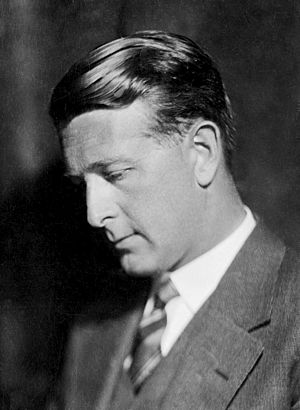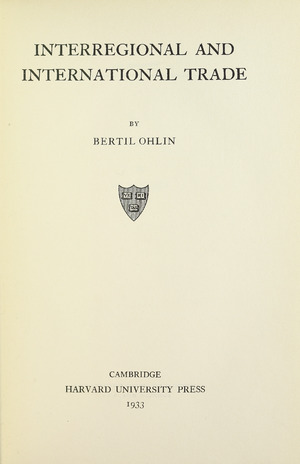Bertil Ohlin facts for kids
Quick facts for kids
Bertil Ohlin
|
|
|---|---|

Bertil Ohlin
|
|
| Minister of Commerce and Industry | |
| In office 1944–1945 |
|
| Prime Minister | Per Albin Hansson |
| Preceded by | Herman Eriksson |
| Succeeded by | Gunnar Myrdal |
| Leader of the People's Party | |
| In office 1944–1967 |
|
| Preceded by | Gustaf Andersson |
| Succeeded by | Sven Wedén |
| Member of the Swedish Parliament for Stockholm Municipality |
|
| In office 1938–1970 |
|
| President of the Nordic Council | |
| In office 1959–1959 |
|
| Preceded by | Nils Hønsvald |
| Succeeded by | Gísli Jónsson |
| In office 1964–1964 |
|
| Preceded by | Nils Hønsvald |
| Succeeded by | Sigurður Bjarnason |
| Personal details | |
| Born | 23 April 1899 Klippan, Sweden |
| Died | 3 August 1979 (aged 80) Åre, Sweden |
| Political party | People's Party |
| Alma mater | B.A. Lund University (1917) MSc. Stockholm School of Economics (1919) M.A. Harvard University (1923) PhD Stockholm University (1924) |
| Known for | Heckscher–Ohlin model Heckscher–Ohlin theorem |
| Awards | Nobel Memorial Prize in Economic Sciences (1977) |
| Scientific career | |
| Fields | Economics |
| Institutions | University of Copenhagen (1925–1930) Stockholm School of Economics (1930–1965) |
| Doctoral advisor | Gustav Cassel |
Bertil Gotthard Ohlin (born April 23, 1899 – died August 3, 1979) was an important Swedish economist and politician. He taught economics at the Stockholm School of Economics for many years.
Ohlin also led the People's Party from 1944 to 1967. This party was the main opposition to the ruling Social Democratic Party at the time. During World War II, he briefly served as Minister of Commerce and Industry from 1944 to 1945. He was also the President of the Nordic Council in 1959 and 1964.
Ohlin is famous for the Heckscher–Ohlin model. This is a key mathematical model used to understand international trade. He developed it with Eli Heckscher. In 1977, he won the Nobel Memorial Prize in Economic Sciences. He shared the prize with British economist James Meade. They were honored for their major work on international trade and the movement of money between countries.
Contents
Bertil Ohlin's Early Life and Studies
Bertil Ohlin grew up in Klippan, Scania, Sweden. He had seven brothers and sisters. His father, Elis, was a civil servant. His mother, Ingeborg, had strong liberal ideas. She believed in cooperation between Nordic countries.
Ohlin was a very good student.
- He earned his first degree from Lund University in 1917.
- He got his master's degree from the Stockholm School of Economics in 1919.
- In 1923, he received another master's degree from Harvard University in the United States.
- He completed his doctorate from Stockholm University in 1924.
In 1925, he became a professor at the University of Copenhagen.
Ohlin's Work in Economics
In 1929, Ohlin had an important debate with John Maynard Keynes. They disagreed about the huge payments (reparations) that Germany had to make after World War I. Keynes thought these payments would cause another war. Ohlin believed Germany could afford them. This debate was important for understanding how money moves between countries.
In 1930, Ohlin became a professor at the Stockholm School of Economics. He took over from his former teacher, Eli Heckscher. In 1933, Ohlin published a book called Interregional and International Trade. This book made him famous worldwide.
The Heckscher–Ohlin Model
In his book, Ohlin built an economic theory of international trade. He used ideas from Heckscher and his own research. This theory is now known as the Heckscher–Ohlin model. It is one of the main models economists use to study trade.
The model showed how a country's comparative advantage (what it's best at producing) is linked to its resources. These resources include its amount of capital (like factories and machines) and labor (workers). The model also showed how these resources can change over time.
Ohlin used his model to create the Heckscher–Ohlin theorem. This theorem says that countries will specialize in industries that best use their national resources. For example, a country with lots of capital might make cars. A country with many workers might make clothes.
Today, some parts of the theory have been challenged. However, it is still a useful way to understand international trade. In 1937, Ohlin was a visiting professor at the University of California, Berkeley.
Ohlin and other economists in the "Stockholm school" also worked on macroeconomics. This is the study of how whole economies work. Their ideas were similar to Keynesianism, which became very popular later.
Ohlin's Political Career
Bertil Ohlin was the leader of the liberal Liberal People's Party. He led the party from 1944 to 1967. This party was the main opposition to the Social Democrat governments.
From 1944 to 1945, he was the Minister of Commerce and Industry. This was during the wartime government. His daughter, Anne Wibble, also became a politician. She served as Minister for Finance from 1991 to 1994. She belonged to the same party.
In 2009, a street next to the Stockholm School of Economics was named "Bertil Ohlins Gata" in his honor.
Heckscher–Ohlin Theorem Explained
The Heckscher–Ohlin theorem comes from the Heckscher–Ohlin model. It explains why countries trade with each other. It says that trade happens based on how much capital (money, machines) and labor (workers) each country has.
- If a country has a lot of capital, wages for workers tend to be high. So, products that need many workers, like textiles, are more expensive to make there.
- Products that need a lot of capital, like cars, are cheaper to make there.
- Countries with lots of capital will export capital-intensive products. They will import products that need more labor.
- Countries with lots of labor will do the opposite.
For this theory to work, some things must be true:
- Countries must have different amounts of capital and labor.
- The goods produced must use more capital or more labor.
- Capital and labor should not move between countries.
- There should be no costs for shipping goods between countries.
- People in the trading countries should have similar needs.
The theory focuses on the amount of capital or labor per worker, not just the total amount. This means small countries can trade with large ones. They can specialize in products that use the resources they have more of. The bigger the difference in resources between two countries, the more they can gain from specializing.
The Leontief Paradox
A famous economist named Wassily Leontief studied this theory. He found something surprising. The United States had a lot of capital. So, it should have exported products that used a lot of capital. But Leontief found that the U.S. exported products that used more labor than the products it imported. This unexpected finding is called the Leontief paradox.
Awards and Decorations
- Commander Grand Cross of the Order of the Polar Star (1965)
See also
 In Spanish: Bertil Ohlin para niños
In Spanish: Bertil Ohlin para niños
- Contributions to liberal theory
- Ohlin Report (1956)
Significant Publications
Bertil Ohlin wrote several important books and reports, including:
- The German Reparations Problem, 1930
- The Cause and Phases of the World Economic Depression, 1931
- Interregional and International Trade, 1933
- Mechanisms and Objectives of Exchange Controls, 1937



